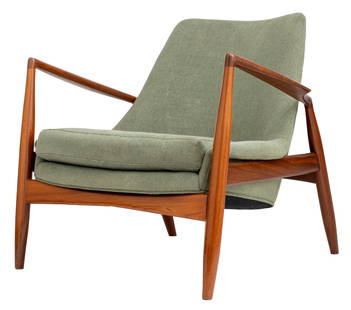
PIERRE JEANNERET (Geneva, 1896-1967). "Easy Chair", 1959. Teak wood and wicker. The seat bears the
Pierre Jeanneret Sale History
View Price Results for Pierre JeanneretRelated Chairs
More Items from Pierre Jeanneret
View MoreRecommended Furniture
View More







Item Details
Description
PIERRE JEANNERET (Geneva, 1896-1967).
"Easy Chair, 1959.
Teak wood and wicker.
The seat bears the inscription: PEC (Punjab Engineering College), Boys Hostel, 59, II.
Measurements: 78 x 50 x 48 cm.
Teak armchair, raised on scissor legs, designed by Pierre Jeanneret in India, between 1955 and 1959, for the Punjab Engineering College. Also called "Model Pj-Si-S8-B", it combines formal economy and elegance in its design. Straight, pure and robust lines combine with clean, geometric and simple forms in which form is allied to function and the handcrafted warmth of teak.
Born in Geneva in 1896, Pierre Jeanneret studied at the Ecole des Beaux-Arts. In 1922 he began working in his new studio in rue de Sèvres, Paris, with his cousin, fellow designer Le Corbusier, with whom he shared research projects and design criteria thanks to a deep professional relationship. In October 1927, the two decided to bring on board a young architect who had already begun to make a name for herself on the architectural scene of the time: Charlotte Perriand. The collaboration of the three personalities lasted until 1937 and was extremely fruitful, especially in the field of furniture design. It was a very significant cooperation, both in terms of the cultural interest of their achievements and in terms of professional success. It was together with Charlotte Perriand that they tackled the innovative project for "l'équipement de la maison", the result of which was of great intellectual value and considerable commercial success. In 1951, Le Corbusier suggested a new project to celebrate India's independence and the opening of the nation to modernity, which consisted of the design of a city, Chandigarh, the capital of Punjab. Chandigarh, in northern India, is a city built from nothing. Designed by Le Corbusier, it was born as an icon of freedom from the colonialism of the past. Pierre Jeanneret is considered - despite the absence of documentation to prove it - the author of most of Chandigarh's furniture. The result is universally known designs, created with respect for the techniques used in the original products, manufactured in India by local craftsmen. Pierre Jeanneret's experience in India lasted until the end of his days in 1967 and his close and continuous contact with the local territory led his furniture to incorporate essential forms with simple materials. Today, Jeanneret's work can be found in museums such as the Museum of Modern Art (MoMA), the Vitra Designs Museum, the Museum Boijmans van Beuningen, the Museum for Gestaktung Zurich, the Museums of India and the Perre Jeanneret Museum.
"Easy Chair, 1959.
Teak wood and wicker.
The seat bears the inscription: PEC (Punjab Engineering College), Boys Hostel, 59, II.
Measurements: 78 x 50 x 48 cm.
Teak armchair, raised on scissor legs, designed by Pierre Jeanneret in India, between 1955 and 1959, for the Punjab Engineering College. Also called "Model Pj-Si-S8-B", it combines formal economy and elegance in its design. Straight, pure and robust lines combine with clean, geometric and simple forms in which form is allied to function and the handcrafted warmth of teak.
Born in Geneva in 1896, Pierre Jeanneret studied at the Ecole des Beaux-Arts. In 1922 he began working in his new studio in rue de Sèvres, Paris, with his cousin, fellow designer Le Corbusier, with whom he shared research projects and design criteria thanks to a deep professional relationship. In October 1927, the two decided to bring on board a young architect who had already begun to make a name for herself on the architectural scene of the time: Charlotte Perriand. The collaboration of the three personalities lasted until 1937 and was extremely fruitful, especially in the field of furniture design. It was a very significant cooperation, both in terms of the cultural interest of their achievements and in terms of professional success. It was together with Charlotte Perriand that they tackled the innovative project for "l'équipement de la maison", the result of which was of great intellectual value and considerable commercial success. In 1951, Le Corbusier suggested a new project to celebrate India's independence and the opening of the nation to modernity, which consisted of the design of a city, Chandigarh, the capital of Punjab. Chandigarh, in northern India, is a city built from nothing. Designed by Le Corbusier, it was born as an icon of freedom from the colonialism of the past. Pierre Jeanneret is considered - despite the absence of documentation to prove it - the author of most of Chandigarh's furniture. The result is universally known designs, created with respect for the techniques used in the original products, manufactured in India by local craftsmen. Pierre Jeanneret's experience in India lasted until the end of his days in 1967 and his close and continuous contact with the local territory led his furniture to incorporate essential forms with simple materials. Today, Jeanneret's work can be found in museums such as the Museum of Modern Art (MoMA), the Vitra Designs Museum, the Museum Boijmans van Beuningen, the Museum for Gestaktung Zurich, the Museums of India and the Perre Jeanneret Museum.
Buyer's Premium
- 26%
PIERRE JEANNERET (Geneva, 1896-1967). "Easy Chair", 1959. Teak wood and wicker. The seat bears the
Estimate €7,000 - €9,000
22 bidders are watching this item.
Shipping & Pickup Options
Item located in Barcelona, -, esOffers In-House Shipping
Payment

TOP













































































